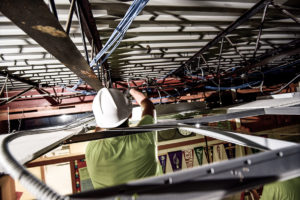05.04.2021
Implementing a Successful Lighting Solution – Part 2
 There are many factors to consider when determining the best way to upgrade a facility to more efficient LED lighting, and each project will have a different perspective on what makes it successful. Earlier this year I shared a blog post about how to implement a successful lighting project, and this article expands on the topic.
There are many factors to consider when determining the best way to upgrade a facility to more efficient LED lighting, and each project will have a different perspective on what makes it successful. Earlier this year I shared a blog post about how to implement a successful lighting project, and this article expands on the topic.
The most significant influences on lighting design are usually cost and budget. Most companies want all the function and control of a network lighting system; however, many budgets only allow for retrofit kits. A good lighting designer will use a variety of techniques to meet your goals and budget. This may include network lighting in critical or high-use areas and standard retrofit kits in areas like hallways, break rooms and restrooms. We always recommend implementing a higher level of technology in a smaller area rather lower technology in more areas. Converting from fluorescent to LED lighting will be the last lighting project that generates a return on investment, so it’s important to get it right the first time.
Another consideration is how the room or area is used. An office would benefit from dimming controls and occupancy sensing for many reasons, whereas a hallway or cafeteria would not. In a school, the gym and auditorium can see great savings by adding scene control, but there is generally not a case for this functionality anywhere else in the building. Similarly, if an area has higher hours of operation, it is worth spending more budget dollars there over a space that is only used a fraction of the time or isn’t seen by the general public.
The condition of existing fixtures can also play a big part in the solution. It may seem more budget-friendly to swap out the components of fixtures with LED. However, by the time you replace broken or depreciated lenses, brittle or damaged sockets and the lamp + ballast components, it may be more cost effective to replace the fixtures completely.
Here are some things to consider when choosing the best lighting upgrades for your facility.
Lamp + Ballast Replacement
Best suited for relatively new lighting and in rooms that don’t have light level deficiencies, if the fixture design is conducive. This is also a good solution for areas with low hours of operation.
| Pros | Cons |
| Lowest cost to implement | More costly to add dimming |
| Generates the best ROI | Compatibility concerns when dimming |
| Relatively long component life | Does not address aesthetic issues |
Volumetric Retrofit
Budget-friendly solution that will improve aesthetics and save a significant amount of energy. This also puts less waste into the landfill.
| Pros | Cons |
| Provides a significant ROI | Requires more components to control |
| Increased efficiency over lamp + ballast solution | Not a great solution for rooms that need fixture spacing adjustments |
| Higher incentives | More effort required on fit and finish |
| Improves fixture aesthetics | More fragile during transport without a rigid frame |
Network Lighting “Smart” Retrofits and/or New Fixtures
Replacing fixtures with new fixtures that include networked lighting may be a higher initial price point, but they offer the most energy savings potential and highest incentives. These fixtures allow occupants to easily control their lit environment.
| Pros | Cons |
| All benefits of volumetric retrofits | Highest cost to implement |
| Highest level of controllability: occupancy sensor, photocontrol, dimming | Lead times on material can be longer |
| Flexibility to make changes to programming if needs change | If existing fixtures are master/satellite, this will require additional wiring |
| Can be incorporated into a Building Management System |
There are hundreds of manufacturers that offer products that fit each category detailed above, and choosing the best manufacturer is a critical component of project success. At Faith Technologies, our team of lighting designers chooses to partner with the top manufacturers in the lighting industry, so you have peace of mind in your chosen solution. Third-tier manufacturers mass produce products without a manufacturer label, which are sold to third-party companies that place their label on it and call it their own. These manufacturers may have only been in business for short amounts of time, and may not be around for the long-term future. Many that started their business within the last 5-10 years have already shut down their operations, never supporting a single warranty claim.
Would you purchase a vehicle from an unknown manufacturer and feel safe putting your family in it? Now consider the fact that your lighting investment may be far more expensive than even a brand-new car. Do you really want to buy the cheapest fixtures on the market? Be sure to choose a lighting partner who helps you ensure that your project is done well today and will serve you well in the future.
If you enjoyed this blog article, please subscribe to stay up to date on the latest industry news from our experts at Faith Technologies.




